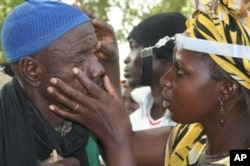Ahead of World Neglected Tropical Diseases Day Monday, the World Health Organization is calling for action to tackle these debilitating illnesses, which affect an estimated 1.65 billion people globally.
A diverse group of 20 parasitic and bacterial tropical diseases is categorized as neglected. This is because they disproportionally affect people who live in poor, remote communities and are not on the list of global health priorities.
Ibrahima Soce Fall is director of WHO’s Department of Neglected Tropical Diseases. He says these vector-borne diseases are transmitted by insects in areas that lack safe water, sanitation, and access to health care. He says they also are spread via contaminated food and water.
Fall says they cause immense suffering because of their disfiguring and disabling impact.
“If you take diseases like onchocerciasis, you know, so-called river blindness because it can lead to blindness. The same for trachoma. So, these are so many diseases that are fatal and very debilitating,” he said.
Trachoma is an eye disease that can cause permanent blindness.
Fall says these diseases do not attract the amount of investment needed to access health services or develop new tools for diagnostics, treatments, and vaccines.
He notes some of these ailments have been around for a very long time. For instance, the biblical disease, leprosy, still exists in 139 countries and dengue, which has been around for 800 years, remains prevalent in 129 nations.
Despite the many challenges, progress is being made in the elimination of the NTDs. WHO reports the number of people requiring NTD interventions fell by 80 million between 2020 and 2021. It finds 47 countries have eliminated at least one NTD and more countries are in the process of achieving this target.
According to the Carter Center, there were only 13 human cases of Guinea worm disease last year, pushing the illness closer to eradication. The Atlanta-based center was co-founded by former U.S. President Jimmy Carter and his wife, Rosalynn Carter. When it began leading the international campaign to eradicate Guinea worm in 1986, there were an estimated 3.5 million cases in at least 21 countries in Africa and Asia.
WHO officials say the goal it has set to eliminate at least one neglected tropical disease in 100 countries by 2030 can be achieved. It says the scientific community has the tools and the know-how to save lives and prevent suffering. But WHO says nations need to act together and invest in helping get rid of this dreaded group of diseases.






